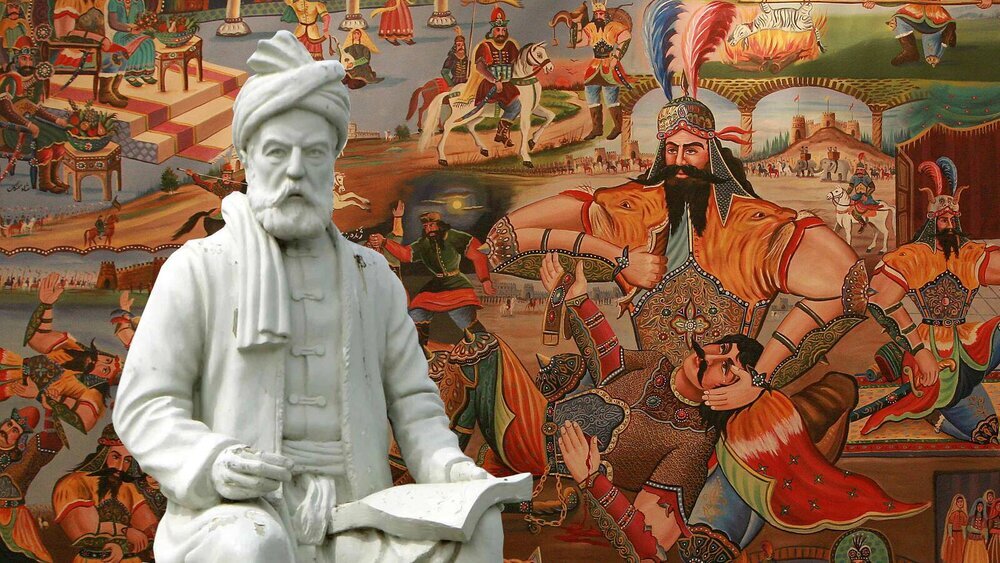This week was the final week of classical Persian poetry. Somehow, we’ve already come to the end of the first topic of this year’s challenge. Which means I really should figure out what I’m going to be doing a deep dive on next month. But that’s Future Me’s problem. Today’s me gets to talk all about the poet Ferdowsi, and the legendary epic Shahnameh. And let me tell you, it did not disappoint.
When I first started researching classical Persian poetry earlier this month, there was one title that kept coming up again and again. Shahnameh. Since it appeared to be so important, I decided to leave it for last. And I’m so happy I did. Because after several weeks of immersing myself in this historical time period, I feel like I can really appreciate just exactly why it’s so important. Not only is this poem the longest poem written by a single author in history, but it is also revered throughout the Middle East. It is a source of national pride for Iranians, and it’s credited with saving the Persian language. It is also considered to be a literary masterpiece. Not just of Persian literature. But of literature. Period.
Which is astonishing to me, because we actually know very little about the author, Ferdowsi. Including his name. Ferdowsi is the most common name attributed to him, but there are many others in use. We also know very little about his life in general. For example, we know that he was born in 940 to a family of dehqans (pre-Islamic Persian aristocrats), and therefore he would have been raised with a sense of duty to preserve pre-Islamic Persian culture and traditions. We also know that he began writing Shahnameh in 977 and finished it in 1010. But other than that, we don’t know anything else for certain. We’re not even sure of the exact date that Ferdowsi died, nor do we have any other surviving works of his. And yet, today, he is considered to be one of the greatest poets in history.
So how did this happen? Well, first of all, I need to point out that Ferdowsi was not the first author of Shahnameh. The poet Daqiqi was actually the original author. He had written about 1,000 verses when he was murdered by one of his slaves. Ferdowsi then took up the task. He used, and acknowledged, Daqiqi’s original verses, and then continued the story to the tune of another 50,000 verses. The story tells the tales of Persian myths, legends, and history, from the beginning of time to the Arab invasion of Persia in the 7th century. It is a sweeping narrative that spans generations and tells the stories of Persian heroes and kings. And it almost singlehandedly prevented Persian culture and the language from being obliterated during the two centuries of silence under Arab rule. As I said, it’s a very important and revered literary work.
I really, really wish I could say that I read the entire book this past week. But the English translation I found was over a thousand pages long. And unless someone wants to pay me to do the Daily Hart full time, I’m not going to be reading a thousand pages in a week any time soon. However, through my research, I discovered that one of the most revered heroes in Shahnameh is Rostam. Think of him as both Achilles and Heracles rolled into one. A majestic warrior who saves both kings and commoners, and who undertakes a series of labours to help liberate his country’s army. He also tragically kills his own son in a case of mistaken identity gone horribly wrong.
My goal was to read the sections about Rostam, but I really only made it to his birth. This was because the story of how his parents got together was an entire epic saga unto itself. They were the typical star-crossed lovers from rival families. But instead of sword fights, the story of how they ultimately got together was one of diplomacy. One side would go talk to the other. And then that side would talk to another branch of the other. And so on and so forth right up until the wedding. Which, by the way, only took up a couple of verses. The negotiations between the two sides, on the other hand, took up several chapters.
And it’s a good thing they did. Those negotiations included some of the most beautiful declarations of love I’ve ever read. They also included themes and plot points that would not be out of place in whatever happens to be the current Netflix obsession. Overall, I couldn’t get over the universality of the themes of this poem. The family dramas and political infighting. The complex relationships and intricate plot twists. It really drove home how little has changed in a thousand years of storytelling.
One day I will read the entirety of Shahnameh, because it truly lives up to its mantle of being an epic. I will also read the other prominent Persian poets from the Golden Age of Persian poetry that I didn’t get to this month. Poets like Ansari, Sana’i, and Hafiz. There is just so much more to read and discover. But I am also incredibly grateful for everything that I learned. When I initially selected classical Persian poetry as my first topic, I had no idea the sheer volume of knowledge I was about to acquire. But I did. And I loved every second of it.
I hope you have enjoyed this deep dive; the first of the second Daily Hart challenge. I’ll be back next Sunday with the next topic. In the meantime, if you have any ideas for future deep dives, I’d love to hear them.
Happy Sunday all!
Suggestions for artists I should check out? Please contact me with your ideas. I hope you enjoyed your daily helping of art!



